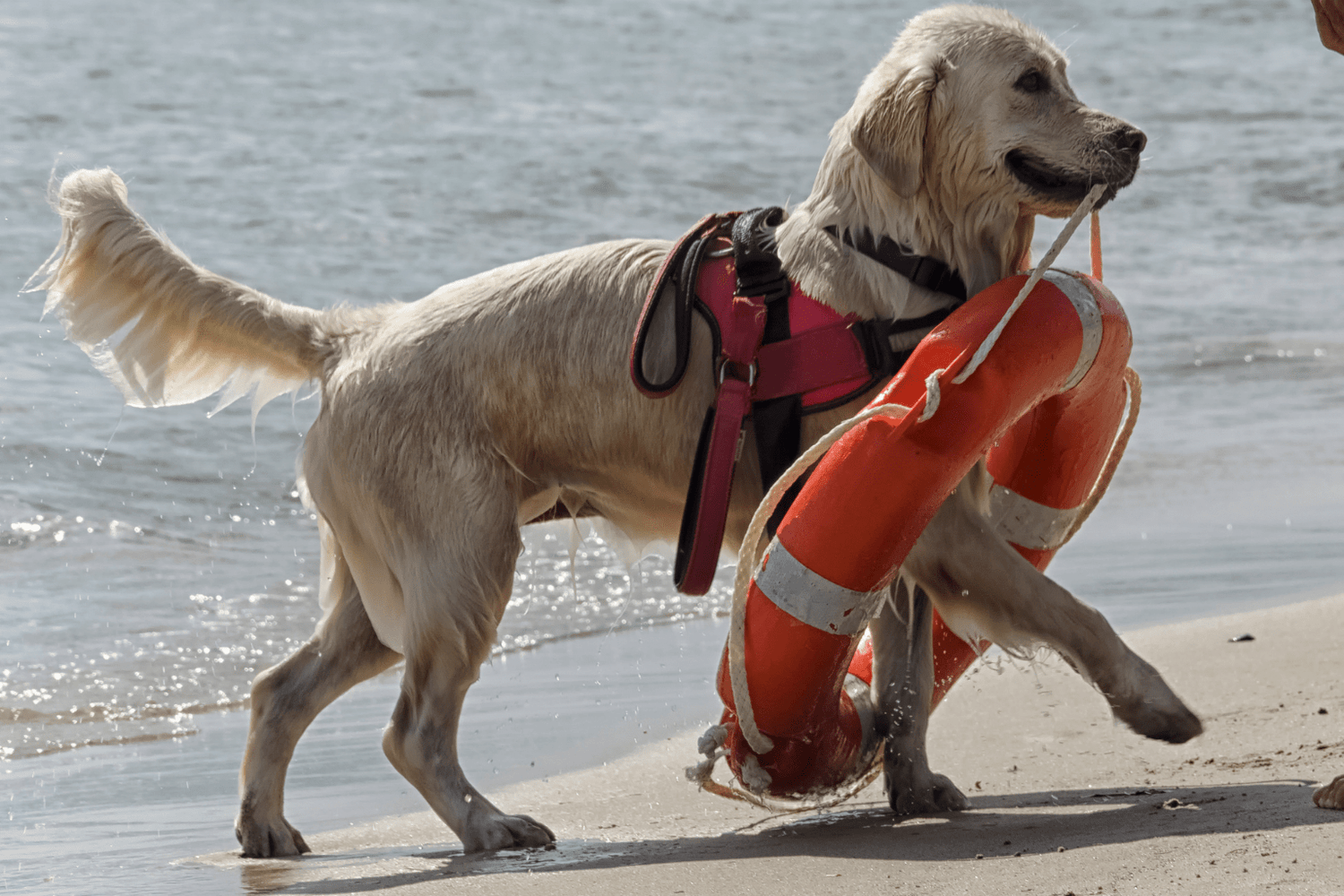Key Takeaways
- Worker dogs have partnered with humans for thousands of years as skilled professionals.
- They perform specialized tasks that require intelligence, loyalty, and training.
- Examples include Border Collies herding sheep and Golden Retrievers assisting people safely.
- Worker dogs fulfill roles that machines cannot replicate.
Table of Contents
- What Are Worker Dogs? A Plain-English Definition for Pet Parents
- The History & Evolution of Working Dogs: From Ancient Helpers to Modern Heroes
- Top Types of Worker Dogs and Their Real-World Roles
- Key Traits of Worker Dogs, Brains, Body, and Heart
- How Working Dogs Are Selected & Trained: Science Meets Heart
- Natural Care & Wellness for Your Working Dog: Solutions Beyond the Chem Lab
- Natural Health Support for Working Dogs
- Choosing the Right Working Dog Breed for Your Needs
- Retirement and Senior Care for Working Dogs
- Working Dogs vs. Pet Dogs: Understanding the Differences
Worker Dogs – Essential Partners, Lifelong Friends: A Natural Pet Parent's Guide
Worker dogs are far more than pets with jobs, they're skilled professionals who've partnered with humans for thousands of years. From the Border Collie who herds sheep at dawn to the Golden Retriever guiding someone safely across busy streets, these remarkable animals combine intelligence, loyalty, and specialized training to perform tasks that machines simply cannot replicate.
Whether you're considering adding a working breed to your family or already share your life with one of these dedicated companions, understanding their unique needs helps ensure they thrive both on and off duty. Dog and cat supplement bundles can provide comprehensive support for active pets, helping them stay healthy and resilient throughout their demanding routines.
Let's explore what makes worker dogs special and how natural wellness approaches can support their active lifestyles. For additional tips on keeping your dog engaged and healthy, you might also find these ideas for how to exercise dogs indoors especially helpful during inclement weather or off-duty days.
What Are Worker Dogs? A Plain-English Definition for Pet Parents
Worker dogs are canines specifically trained or bred to perform jobs that benefit humans, from guiding the visually impaired to detecting explosives. Unlike companion dogs who primarily provide emotional support and friendship, or show dogs bred for appearance, worker dogs are evaluated on their ability to complete specific tasks reliably and safely.
| Dog Type | Primary Role | Key Traits | Daily Requirements |
|---|---|---|---|
| Worker Dogs | Perform specific jobs | Task-focused, trainable, resilient | 2-4 hours exercise, mental stimulation |
| Companion Dogs | Provide friendship | Affectionate, adaptable, social | 1-2 hours activity, regular interaction |
| Show Dogs | Compete in conformation | Breed-standard appearance | Grooming, conditioning, training |
Take Bailey, a Border Collie who spends mornings herding sheep on a Montana ranch. Her intense focus, problem-solving skills, and natural herding instincts make her invaluable to the farm's daily operations, traits that also make her a devoted family companion when work ends.
The History & Evolution of Working Dogs: From Ancient Helpers to Modern Heroes

The partnership between humans and worker dogs began over 15,000 years ago when early wolves helped with hunting and protection. This collaboration evolved as human societies developed, with dogs adapting to increasingly specialized roles that shaped entire breeds.
Key Milestones in Working Dog History
- Ancient Times: First livestock guardian dogs protect flocks in Asia and Europe
- 1750s: Specialized herding breeds developed in Scotland and Wales
- 1916: First guide dog school opens in Germany for WWI veterans
- 1929: The Seeing Eye establishes guide dog training in America
- 1990s: Detection dogs begin identifying medical conditions like seizures
- 2000s: Psychiatric service dogs gain legal recognition
Modern worker dogs excel at tasks requiring emotional intelligence, scent discrimination, and split-second decision-making, capabilities that remain beyond current technology. Their breeding emphasized not just physical traits like webbed feet for water rescue or thick coats for cold climates, but cognitive abilities like problem-solving and stress resilience that make them irreplaceable partners in critical situations.
Top Types of Worker Dogs and Their Real-World Roles
Today's worker dogs fill diverse roles across multiple industries, each requiring specific skills and temperaments. Understanding these specializations helps appreciate the remarkable versatility of our canine partners.
Service Dogs
Role: Provide life-changing assistance to individuals with disabilities, from mobility support to seizure detection. Breeds like Labrador Retrievers and Golden Retrievers excel due to their calm temperament and eagerness to please. Max, a chocolate Lab, alerts his handler to dangerous blood sugar drops and can even fetch emergency medication on command.
Therapy Dogs
Role: Offer emotional comfort in hospitals, schools, and disaster areas. Unlike service dogs, therapy dogs work with multiple people and focus on providing stress relief through gentle interaction. Cavalier King Charles Spaniels and Poodles are popular choices for their naturally soothing presence.
Detection Dogs
Role: Use their incredible scent abilities to locate everything from drugs and explosives to bed bugs and even certain cancers. German Shepherds and Belgian Malinois dominate police work, while Beagles excel at airport agricultural inspections due to their friendly appearance and relentless tracking instincts.
Herding Dogs
Role: Manage livestock through instinctive behaviors like "the eye" (intense staring) and strategic positioning. Border Collies and Australian Cattle Dogs can control hundreds of sheep or cattle with minimal human direction, making them indispensable on working ranches.
Considering a working breed? Plan for 2-3 hours of daily mental and physical exercise. These dogs need jobs to stay happy, even if that job is learning new tricks or participating in dog sports.
Search and Rescue Dogs
Role: Locate missing persons in wilderness areas, disaster sites, and avalanche zones. These dogs work in extreme conditions, using both air-scenting and tracking skills. German Shepherds and Labrador Retrievers dominate this field due to their endurance, weather resistance, and ability to work independently when separated from handlers.
Military Working Dogs
Role: Serve alongside military personnel in combat zones, detecting explosives, tracking enemies, and providing base security. Belgian Malinois have become the preferred breed for special operations due to their compact size, fierce loyalty, and ability to parachute with their handlers into hostile territory.
Considering a Working Breed? These dogs need 2-4 hours of daily mental and physical stimulation. Without proper outlets for their drive, working breeds can become destructive or anxious. Plan for puzzle toys, agility training, or structured activities that engage their natural instincts.
Key Traits of Worker Dogs, Brains, Body, and Heart
Worker dogs possess a unique combination of physical and mental characteristics that enable them to excel in demanding roles. These traits weren't accidental, they were carefully selected over generations to create dogs capable of performing complex tasks under pressure.
Physical attributes vary by job requirements. Sled dogs like Alaskan Malamutes have thick double coats and powerful hindquarters for pulling heavy loads across frozen terrain. Water rescue dogs such as Newfoundlands feature webbed feet and waterproof coats that allow them to swim in icy conditions for hours. Police dogs typically have lean, athletic builds that combine speed with strength.
Mental and emotional traits are equally important. Most worker dogs demonstrate exceptional problem-solving abilities, learning complex command sequences of 40 or more distinct cues. They show remarkable stress resilience, maintaining focus during loud noises, chaotic environments, or emergency situations that would overwhelm typical pets. The famous "herding eye" of Border Collies, an intense, focused stare, exemplifies how specific behaviors were bred to enhance job performance.
Does Your Dog Have Working DNA? Quick Assessment
- Does your dog learn new commands within 5-10 repetitions?
- Can they maintain focus on a task for 15+ minutes without distraction?
- Do they naturally "work" by herding family members, guarding the house, or retrieving items?
- Are they comfortable with strangers and new environments?
- Do they seem happiest when given a "job" to do?
Three or more "yes" answers suggest strong working dog traits.
Worker dogs are also at risk for certain joint and mobility issues due to their active lifestyles. If you're concerned about your dog's movement or notice signs of discomfort, you may want to learn more about hip dysplasia in dogs, signs, and treatments to help keep your canine partner healthy and comfortable.
How Working Dogs Are Selected & Trained: Science Meets Heart

Professional working dog programs use rigorous selection processes that evaluate puppies as early as 7-8 weeks old. Trainers assess temperament, drive, and physical soundness through standardized tests. For service dogs, puppies undergo socialization evaluations in busy environments like shopping centers and airports. Those showing calm confidence while maintaining engagement with their handler advance to formal training.
Training timelines vary by specialization but typically span 12-24 months. Service dogs begin basic obedience and public access training at 8 weeks, progress through advanced task training at 12-18 months, and graduate around 2 years old. Detection dogs focus intensively on scent discrimination, learning to identify target odors while ignoring distractions, a process that can take 6-12 months depending on the complexity of their assignment.
| Dog Type | Training Start | Working Age | Typical Retirement |
|---|---|---|---|
| Service Dogs | 8 weeks | 18-24 months | 8-10 years |
| Police Dogs | 12-18 months | 2-3 years | 7-9 years |
| Military Dogs | 12-18 months | 2-4 years | 8-10 years |
| Therapy Dogs | 6 months | 12-18 months | 10-12 years |
Pet parents can apply professional training principles at home through structured brain games. Hide treats around the house for scent work, teach your dog to retrieve specific items by name, or create obstacle courses using household furniture. These activities satisfy working breed instincts while strengthening your bond.
For more insight into the science behind working dog cognition and training, see this comprehensive review on the cognitive and behavioral abilities of working dogs.
Natural Care & Wellness for Your Working Dog: Solutions Beyond the Chem Lab
Worker dogs face unique physical and mental demands that require thoughtful wellness approaches. Their high-stress environments, intensive training schedules, and physical demands can lead to joint strain, muscle tension, and anxiety, areas where natural, homeopathic support can make a meaningful difference in their daily comfort and long-term health.
At BestLife4Pets, we've seen countless working dogs benefit from gentle, natural remedies that support their bodies' own healing processes. Our pellet formulas are specifically designed for active dogs, offering targeted support for joint flexibility, stress management, and recovery without the side effects often associated with conventional medications. These pellets integrate seamlessly into daily routines, whether you're managing joint stiffness in an aging service dog or helping a therapy dog stay calm during stressful hospital visits.
For working dogs recovering from injury or surgery, it's important to follow best practices for aftercare. You can find helpful tips in this guide to hip and joint surgery after care tips for dogs and cats.
Natural Health Support for Working Dogs
Worker dogs face unique physical and mental demands that require specialized care beyond basic pet maintenance. Their bodies endure repetitive stress, their minds stay constantly engaged, and their emotional well-being depends on maintaining peak performance while bonding with handlers.
Traditional veterinary care often relies on prescription medications that can carry unwanted side effects, particularly concerning for dogs whose careers depend on sharp senses and quick reflexes. Natural homeopathic remedies offer a gentler first-line approach to supporting your working dog's health.
BestLife4Pets formulations are designed for active dogs, offering targeted support for joint flexibility, stress management, and recovery without the side effects often associated with conventional medications. These pellets integrate seamlessly into daily routines, whether you're managing joint stiffness or helping a therapy dog decompress after hospital visits.
Real Success Story: Max, a 7-year-old German Shepherd working in airport security, showed renewed enthusiasm for his detection work after his handler introduced our Walk-Easy® Hip & Joint Pain Relief to his morning routine. His veterinarian noted improved mobility during quarterly health checks.
The key is consistency and early intervention. Working dogs benefit most when natural support becomes part of their regular wellness routine rather than a reactive measure after problems develop. To provide your working dog with comprehensive wellness, consider dog and cat supplement bundles that address joint, stress, and immune health needs.
Choosing the Right Working Dog Breed for Your Needs

Not all worker dogs suit every lifestyle or job requirement. Success depends on matching breed characteristics with specific tasks and living situations.
For Service Work: Labrador Retrievers and Golden Retrievers excel due to their calm temperament and eagerness to please. Their size provides stability for mobility assistance while their gentle nature suits public access requirements.
For Protection: German Shepherds and Belgian Malinois offer intelligence and loyalty, but require experienced handlers who can provide adequate mental stimulation and physical exercise.
For Therapy Work: Cavalier King Charles Spaniels and Poodles bring the right combination of gentleness and social confidence needed in hospitals and schools.
For Detection Work: Beagles and German Shorthaired Pointers possess the scenting ability and drive necessary for drug, explosive, or medical detection tasks.
| Breed Type | Energy Level | Training Complexity | Best Suited For |
|---|---|---|---|
| Labrador Retriever | Moderate-High | Beginner-Friendly | Service, Therapy |
| German Shepherd | High | Advanced | Police, Military, Protection |
| Border Collie | Very High | Advanced | Herding, Search & Rescue |
| Beagle | Moderate | Intermediate | Detection, Tracking |
Consider your experience level, available time for training, and long-term commitment. Working breeds typically live 10-14 years and maintain their drive well into senior years with proper care. For a scientific perspective on breed selection and working dog suitability, review this article on the genetics and selection of working dogs.
Retirement and Senior Care for Working Dogs
Every working dog eventually faces retirement, whether due to age, injury, or changing job requirements. This transition requires thoughtful planning to maintain their quality of life and sense of purpose.
Signs your working dog may be ready for retirement include decreased enthusiasm for tasks, slower response times, difficulty with physical demands, or increased recovery time after work sessions. These changes typically appear between ages 8-12, depending on the breed and type of work.
Creating a Successful Transition:
- Gradually reduce work hours rather than stopping abruptly
- Introduce new, less demanding activities that provide mental stimulation
- Maintain familiar routines while allowing more rest time
- Consider natural joint support to ease age-related stiffness
Many retired working dogs thrive in new roles, former police dogs become beloved family pets, retired service dogs enjoy simple companionship, and aged therapy dogs find fulfillment in gentle interactions with children or seniors.
BestLife4Pets' gentle formulations support this transition by addressing common senior dog concerns like joint stiffness, anxiety from routine changes, and age-related discomfort. The pellets' ease of administration makes daily wellness support simple for both dog and owner. If you're looking for a convenient way to support your senior working dog's health, explore dog and cat supplement bundles designed for aging pets.
Working Dogs vs. Pet Dogs: Understanding the Differences
The distinction between working dogs and companion pets extends beyond their daily activities to fundamental differences in breeding, training, and lifestyle needs.
Breeding Focus: Working dog lines prioritize functional traits, scenting ability, physical endurance, problem-solving intelligence, and task drive. Pet dog breeding often emphasizes appearance, temperament, and companionability.
Daily Requirements: Working dogs need structured mental challenges and physical exercise that mirrors their bred purpose. A Border Collie requires herding-type activities, while a Bloodhound benefits from scent work. Pet dogs typically satisfy their exercise needs with walks and play.
Training Intensity: Working dogs undergo extensive, specialized training that can take 18-24 months. They learn complex command sequences and must perform reliably under stress. Pet dogs learn basic obedience and social skills primarily for companionship.
Not a substitute for professional veterinary advice.
Frequently Asked Questions
What distinguishes worker dogs from companion and show dogs in terms of their roles and daily needs?
Worker dogs are trained to perform specific tasks that benefit humans, such as herding or guiding, whereas companion dogs mainly provide emotional support and show dogs are bred for appearance. Their daily needs include more focused exercise, mental stimulation, and consistent training to maintain their skills and well-being.
How have working dogs evolved throughout history to fulfill specialized tasks alongside humans?
Working dogs have partnered with humans for thousands of years, evolving from general helpers to highly specialized professionals. Over time, selective breeding and training have honed their intelligence, loyalty, and physical abilities to meet the demands of roles that machines cannot replicate.
What are the key traits that make certain dog breeds well-suited for specific working roles?
Key traits include intelligence, trainability, physical endurance, and a strong bond with humans. These qualities help working dogs focus on tasks, adapt to challenges, and perform reliably in roles like herding, guiding, or search and rescue.
How can natural health and wellness approaches support the performance and well-being of working dogs?
Natural health approaches, such as homeopathic remedies and balanced nutrition, support a working dog’s body and mind by promoting comfort, resilience, and recovery. These gentle solutions complement training and care routines, helping dogs maintain peak performance without relying solely on chemicals.



